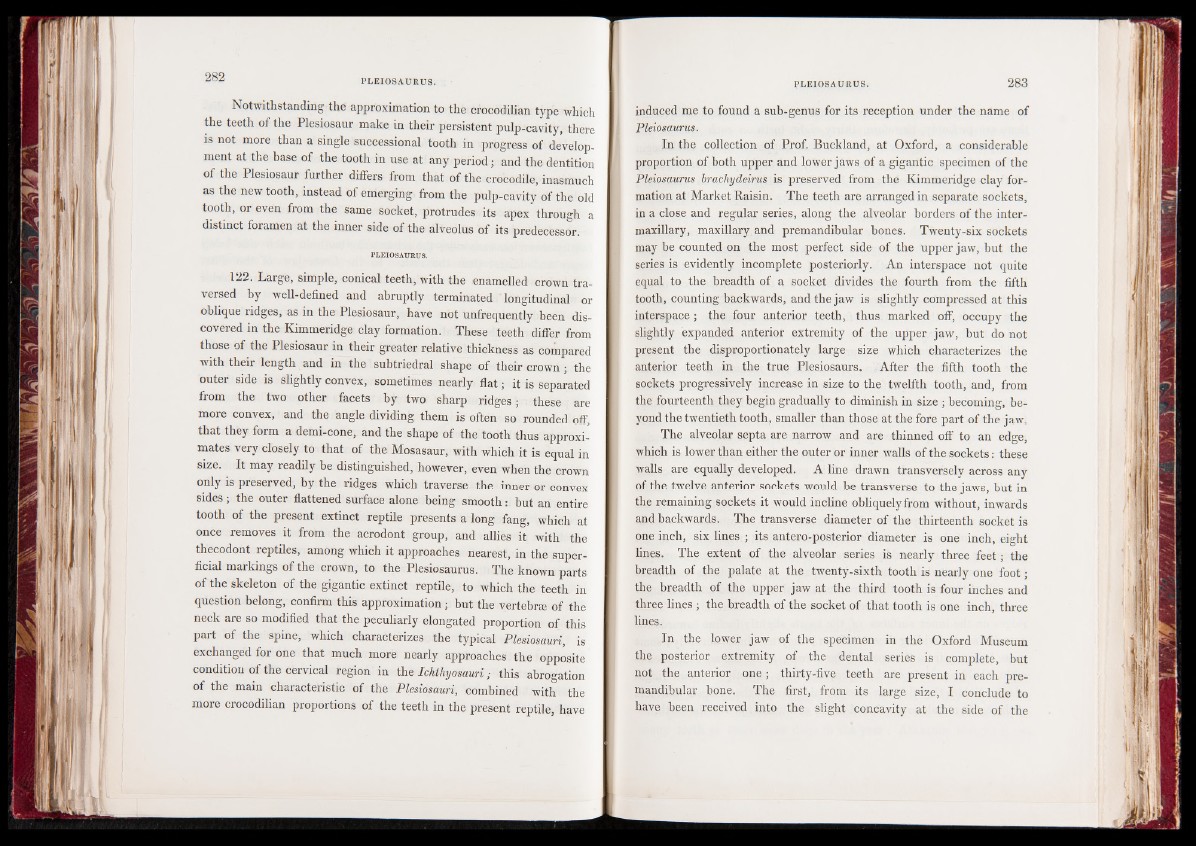
Notwithstanding the approximation to the crocodilian type which
the teeth of the Plesiosaur make in their persistent pulp-cavity, there
is not more than a single successional tooth in progress of development
at the base of the tooth in use at any period I and the dentition
of the Plesiosaur further differs from that of the crocodile, inasmuch
as the new tooth, instead of emerging from the pulp-cavity of the old
tooth, or even from the same socket, protrudes its apex through a
distinct foramen at the inner side of the alveolus of its predecessor.
PLEIOSAURUS.
122. Large, simple, conical teeth, with the enamelled crown traversed
by well-defined and abruptly terminated longitudinal or
oblique ridges, as in the Plesiosaur, have not unfrequently been discovered
in the Kimmeridge clay formation. These teeth differ from
those of the Plesiosaur in their greater relative thickness as compared
with their length and in the subtriedral shape of their crown ; the
outer side is slightly convex, sometimes nearly flat; it is separated
from the two other facets by two sharp ridges; these are
more convex, and the angle dividing them is often so rounded off,
that they form a demi-cone, and the shape of the tooth thus approximates
very closely to that of the Mosasaur, with which it is equal in
size. It may readily be distinguished, however, even when the crown
only is preserved, by the ridges which traverse the inner or convex
sides; the outer flattened surface alone being smooth: but an entire
tooth of the present extinct reptile presents a long fang, which at
once removes it from the acrodont group, and allies it with the
thecodont reptiles, among which it approaches nearest, in the superficial
markings of the crown, to the Plesiosaurus. The known parts
of the skeleton of the gigantic extinct reptile, to which the teeth in
question belong, confirm this approximation; but the vertebrae of the
neck are so modified that the peculiarly elongated proportion of this
part of the spine, which characterizes the typical Plesiosauri, is
exchanged for one that much more nearly approaches the opposite
condition of the cervical region in the Ichthyosauri; this abrogation
of the main characteristic of the Plesiosauri, combined with the
more crocodilian proportions of the teeth in the present reptile, have
induced me to found a sub-genus for its reception under the name of
Pleiosaurus.
In the collection of Prof. Buckland, at Oxford, a considerable
proportion of both upper and lower jaws of a gigantic specimen of the
Pleiosaurus brachydeirus is preserved from the Kimmeridge clay formation
at Market Raisin. The teeth are arranged in separate sockets,
in a close and regular series, along the alveolar borders of the intermaxillary,
maxillary and premandibular bones. Twenty-six sockets
may be counted on the most perfect side of the upper jaw, but the
series is evidently incomplete posteriorly. An interspace not quite
equal to the breadth of a socket divides the fourth from the fifth
tooth, counting backwards, and the jaw is slightly compressed at this
interspace; the four anterior teeth, thus marked off, occupy the
slightly expanded anterior extremity of the upper jaw, but do not
present the disproportionately large size which characterizes the
anterior teeth in the true Plesiosaurs. After the fifth tooth the
sockets progressively increase in size to the twelfth tooth, and, from
the fourteenth they begin gradually to diminish in size ; becoming, beyond
the twentieth tooth, smaller than those at the fore part of the jaw.
The alveolar septa are narrow and are thinned off to an edge,
which is lower than either the outer or inner walls of the sockets | these
walls are equally developed. A line drawn transversely across any
of the twelve anterior sockets would be transverse to the jaws, but in
the remaining sockets it would incline obliquelyfrom without, inwards
and backwards. The transverse diameter of the thirteenth socket is
one inch, six lines ; its antero-posterior diameter is one inch, eight
lines. The extent of the alveolar series is nearly three feet; the
breadth of the palate at the twenty-sixth tooth is nearly one foot;
the breadth of the upper jaw at the third tooth is four inches and
three lines ; the breadth of the socket of that tooth is one inch, three
lines.
In the lower jaw of the specimen in the Oxford Museum
the posterior extremity of the dental series is complete, but
not the anterior one; thirty-five teeth are present in each premandibular
bone. The first, from its large size, I conclude to
have been received into the slight concavity at the side of the